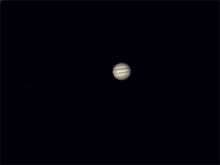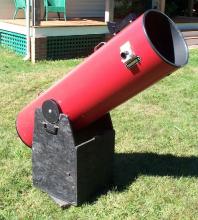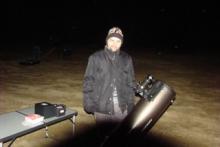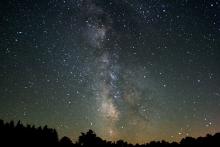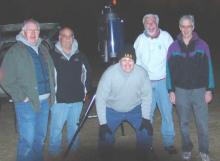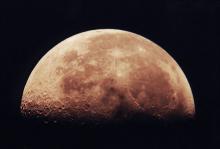Don't miss the meeting, coming up this week!
Science Daily

Astronomy news. New! Earth-like extrasolar planet found; double helix nebula; supermassive black holes, astronomy articles, astronomy pictures. Updated daily.
Updated: 20 hours 54 min ago
Eruption of mega-magnetic star lights up nearby galaxy
While ESA's satellite INTEGRAL was observing the sky, it spotted a burst of gamma-rays -- high-energy photons -- coming from the nearby galaxy M82. Only a few hours later, ESA's XMM-Newton X-ray space telescope searched for an afterglow from the explosion but found none. An international team realized that the burst must have been an extra-galactic flare from a magnetar, a young neutron star with an exceptionally strong magnetic field.
Toward unification of turbulence framework -- weak-to-strong transition discovered in turbulence
Astrophysicists have made a significant step toward solving the last puzzle in magnetohydrodynamic turbulence theory by observing the weak to strong transition in the space plasma turbulence surrounding Earth with newly developed multi-spacecraft analysis methods.
To find life in the universe, look to deadly Venus
Despite surface temperatures hot enough to melt lead, lava-spewing volcanoes, and puffy clouds of sulfuric acid, uninhabitable Venus offers vital lessons about the potential for life on other planets, a new paper argues.
Giant galactic explosion exposes galaxy pollution in action
Astronomers have produced the first high-resolution map of a massive explosion in a nearby galaxy, providing important clues on how the space between galaxies is polluted with chemical elements.
AI and physics combine to reveal the 3D structure of a flare erupting around a black hole
Based on radio telescope data and models of black hole physics, a team has used neural networks to reconstruct a 3D image that shows how explosive flare-ups in the disk of gas around our supermassive black hole might look.
Astronomers uncover methane emission on a cold brown dwarf
Astronomers have discovered methane emission on a brown dwarf, an unexpected finding for such a cold and isolated world. The findings suggest that this brown dwarf might generate aurorae similar to those seen on our own planet as well as on Jupiter and Saturn.
'Tube map' around planets and moons made possible by knot theory
Scientists have developed a new method using knot theory to find the optimal routes for future space missions without the need to waste fuel.
No gamma rays seen coming from nearby supernova
A nearby supernova in 2023 offered astrophysicists an excellent opportunity to test ideas about how these types of explosions boost particles, called cosmic rays, to near light-speed. But surprisingly, NASA's Fermi Gamma-ray Space Telescope detected none of the high-energy gamma-ray light those particles should produce.
Most massive stellar black hole in our galaxy found
Astronomers have identified the most massive stellar black hole yet discovered in the Milky Way galaxy. This black hole was spotted in data from the European Space Agency's Gaia mission because it imposes an odd 'wobbling' motion on the companion star orbiting it. Astronomers have verified the mass of the black hole, putting it at an impressive 33 times that of the Sun.
Physicists solve puzzle about ancient galaxy found by Webb telescope
Physicists solve a puzzle linked to JWST-ER1g, a massive ancient galaxy that formed when the universe was just a quarter of its current age.
Physicists solve puzzle about ancient galaxy found by Webb telescope
Physicists solve a puzzle linked to JWST-ER1g, a massive ancient galaxy that formed when the universe was just a quarter of its current age.
Brightest gamma-ray burst of all time came from the collapse of a massive star
In 2022, astronomers discovered the brightest gamma-ray burst (GRB) of all time. Now, astronomers confirm that a 'normal' supernova, the telltale sign of a stellar collapse, accompanied the GRB. The team also looked for signatures of heavy elements like gold and platinum in the supernova. They found no evidence of such elements, deepening the mystery of their origins.
Stellar winds of three sun-like stars detected for the first time
An international research team has for the first time directly detected stellar winds from three Sun-like stars by recording the X-ray emission from their astrospheres, and placed constraints on the mass loss rate of the stars via their stellar winds.
Exoplanets true to size
A star's magnetic field must be considered in order to correctly determine the characteristics of exoplanets from observations by space telescopes such as Kepler, James Webb, or PLATO. Researchers show that the distribution of the star's brightness over its disk depends on the star's level of magnetic activity. This, in turn, affects the signature of an exoplanet in observational data. The new model must be used in order to properly interpret the data from the latest generation of space telescopes pointed at distant worlds outside our Solar System.
Beautiful nebula, violent history: Clash of stars solves stellar mystery
When astronomers looked at a stellar pair at the heart of a stunning cloud of gas and dust, they were in for a surprise. Star pairs are typically very similar, like twins, but in HD 148937, one star appears younger and, unlike the other, is magnetic. New data suggest there were originally three stars in the system, until two of them clashed and merged. This violent event created the surrounding cloud and forever altered the system's fate.
The hidden role of the Milky Way in ancient Egyptian mythology
Astrophysicists shed light on the relationship between the Milky Way and the Egyptian sky-goddess Nut. The paper draws on ancient Egyptian texts and simulations to argue that the Milky Way might have shone a spotlight, as it were, on Nut's role as the sky. It proposes that in winter, the Milky Way highlighted Nut's outstretched arms, while in summer, it traced her backbone across the heavens.
Inexplicable flying fox found in Hydra galaxy cluster
High sensitivity radio observations have discovered a cloud of magnetized plasma in the Hydra galaxy cluster. The odd location and shape of this plasma defy all conventional explanations. Dubbed the Flying Fox based on its silhouette, this plasma will remain a mystery until additional observations can provide more insight.
Telescope detects unprecedented behavior from nearby magnetar
Captured by cutting-edge radio telescope technology, a chance reactivation of a magnetar -- the Universe's most powerful magnets -- has revealed an unexpectedly complex environment.
Neutron stars are key to understanding elusive dark matter
Scientists may be one step closer to unlocking one of the great mysteries of the universe after calculating that neutron stars might hold a key to helping us understand elusive dark matter.
CHEOPS detects a 'rainbow' on an exoplanet
The CHEOPS space telescope is providing new information on the mysterious exoplanet WASP-76b. This ultra-hot giant is characterized by an asymmetry between the amount of light observed on its eastern terminator -- the fictitious line that separates its night side from its day side -- and that observed on its western terminator. This peculiarity is thought to be due to a 'glory', a luminous phenomenon similar to a rainbow, which occurs if the light from the star -- the 'sun' around which the exoplanet orbits -- is reflected by clouds made up of a perfectly uniform substance. If this hypothesis is confirmed, this would be the first detection of this phenomenon outside our solar system.

